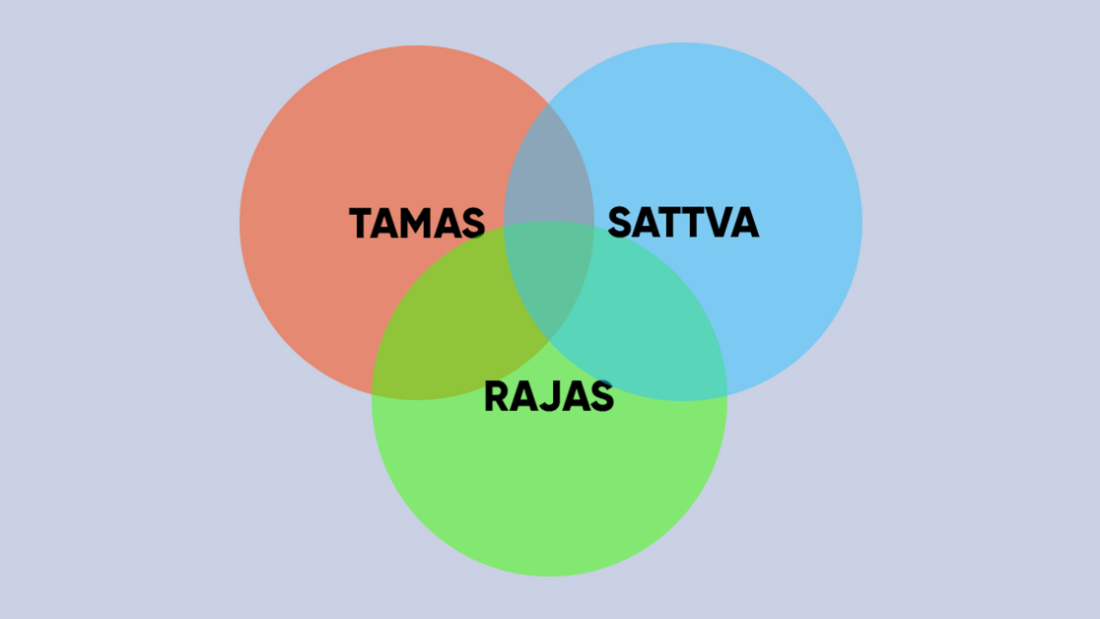“Sattva” is a Sanskrit term that refers to a state of purity, honesty, positivity, clarity, balance and truth in one’s thoughts, emotions, and actions. It is one of the three qualities or ‘Gunas’ (modes of existence) as described in our good old scriptures, alongside the two other ‘Gunas’ – ‘Rajas’ (passion and activity) and ‘Tamas’ (destruction and chaos). All three ‘Gunas’ are found in everything and everyone but in different proportions and contexts. No one is purely “Sattvic” or ‘Rajasic’ or ‘Tamasic’. All of us are a mix of all three ‘Gunas’, depending on our nature and behaviour. However, we all must try our best to keep the proportion of “Sattva” the highest.
Let’s understand the three ‘Gunas’ in a playful manner!
- “Sattva” is like a white cloud in the sky. You are light, peaceful, serene, and balanced. You are not attached to anything or anyone. You are just floating and enjoying the view. You are drawn towards knowledge and virtue. You are “Sattvic”.
- ‘Rajas’ is like a red firework that explodes in the night. You are bright, dynamic, energetic, and exciting. You are always moving and doing something. You are self-centred and egoistic. You are driven by your desires and emotions. You are ‘Rajasic’.
- ‘Tamas’ is like a black hole that sucks everything in. You are dark, dull, inert, and negative. You are chaotic and destructive. You are ignorant and deluded. You are apathetic and lazy. You are ‘Tamasic’.
RAJAS
- Movement
- Activity
- Energy
- Excitement
- Passion
- Desire
- Agitation
- Anxiety
- Egotism
SATTVA
- Balance
- Harmony
- Positivity
- Peace
- Clarity
- Light
- Creativity
- Openness
- Intelligence
TAMAS
- Inertia
- Inactivity
- Negative
- Apathy
- Dullness
- Dark
- Delusion
- Depression
- Ignorance
To balance the three ‘Gunas’, you can follow a yogic diet or try fasting, engage in balancing asanas, and give calming meditation a whirl. The aim is to increase the “Sattva” ‘Guna’ which will fill you with compassion, truth, and a selfless attitude. Balancing these Gunas is considered an important goal for spiritual development and personal growth. Here are some ways to balance the three Gunas:
- Cultivate awareness: Becoming aware of our thoughts, emotions, and actions is the first step towards balancing the ‘Gunas’. We can develop this awareness through practices like meditation, yoga, and mindfulness.
- Choose “Sattvic” activities: Engage in activities that promote “Sattva”, such as spending time in nature, listening to uplifting music, and practising acts of kindness, forgiveness, gratitude and compassion towards living and also non-living beings.
- Minimise ‘Rajasic’ activities: Reduce activities that promote ‘Rajas’, such as overworking, overeating, and indulging in excessive sensory pleasures.
- Avoid ‘Tamasic’ activities: Avoid activities that promote ‘Tamas’, such as laziness, apathy, and excessive sleep.
- Practice moderation: Balancing the ‘Gunas’ requires a sense of moderation in all areas of life, including work, food, exercise, and leisure activities. Excess in any area can tip the balance towards one of the ‘Gunas’.
- Seek guidance: Seek the guidance of a spiritual teacher or mentor who can help you understand the ‘Gunas’ and how to balance them in your life.
Remember, balancing the ‘Gunas’ is a lifelong process that requires patience, commitment, and self-awareness. By cultivating a balanced state of mind and living a balanced lifestyle, we can gradually reduce the influence of the ‘Rajas’ and ‘Tamas’ Gunas and experience greater peace, harmony, and fulfilment in our lives.
When “Sattva” ‘Guna’ increases in a person, it results in various positive effects on the body, on the spiritual as well as at the mental level. The person becomes cheerful, happy and full of gratitude. Also, he/she gains self-control, kind and non-violent behaviour. “Sattva” quality fills the person with wisdom and brings a sense of maturity inside him/her. The person easily understands the difference between need and want, good and bad, devoted and non-devoted actions. The individual performs his duty or works with honesty and goodwill. There are infinite benefits to cultivating “Sattva” in our lives and can positively impact our physical, mental, and spiritual well-being. Here are some of the benefits of “Sattva”:
- Inner peace: “Sattva” promotes a sense of inner peace and tranquillity. When we cultivate “Sattva”, we can let go of negative thoughts and emotions that disturb our inner calm.
- Clarity of mind: “Sattva” brings clarity to our thoughts and helps us make wise decisions. We can think more clearly and objectively, and we can see situations and problems from a broader perspective.
- Improved health: “Sattvic” practices such as yoga, meditation, and a healthy diet can improve our physical health by reducing stress, lowering blood pressure, and boosting immunity.
- Greater empathy and compassion: “Sattva” helps us develop a sense of empathy and compassion towards others. We can see their struggles and pain with greater clarity and respond with kindness and understanding.
- Increased creativity: “Sattva” enhances our creativity by opening our minds to new ideas and possibilities. We can think outside the box and explore new avenues of expression.
- Spiritual growth: “Sattva” is considered an important aspect of spiritual growth. By cultivating “Sattva”, we can develop a deeper connection with our inner self and the divine, leading to greater spiritual awareness and enlightenment.
Overall, the benefits of “Sattva” are profound and can enhance every aspect of our lives. By cultivating a state of purity, clarity, and balance, we can experience greater peace, joy, and fulfilment in our lives!


